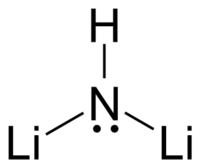Lithium imide
 | |
| Names | |
|---|---|
| IUPAC name
Lithium imide | |
| Identifiers | |
| 12135-01-2 | |
| Properties | |
| Li2NH | |
| Molar mass | 28.897 g/mol |
| Density | 1.48 g/cm3 |
| Except where otherwise noted, data are given for materials in their standard state (at 25 °C [77 °F], 100 kPa). | |
| Infobox references | |
Lithium imide is an inorganic compound with the chemical formula Li
2NH. This white solid can be formed by a reaction between lithium amide and lithium hydride.[1]
- LiNH2 + LiH → Li2NH + H2
The product is light-sensitive and can undergo disproportionation to form lithium nitride, which is characteristically red.
- 2 Li2NH → LiNH2 + Li3N
Lithium imide is thought to have a simple face-centered cubic structure with a Fm3m space group; with N-H bond distances of 0.82(6) Å and a H–N–H bond angle of 109.5°, giving it a similar structure to lithium amide.[2][3]
Lithium imide is strongly basic and could have uses in organic and organometallic chemistry. It has been investigated as a material for hydrogen storage.[1]
References
- 1 2 Ichikawa, Takayuki; Hanada, Nobuko; Isobe, Shigehito; Leng, Haiyan; Fujii, Hironobu (June 2004). "Mechanism of Novel Reaction from LiNH2 and LiH to Li2NH and H2 as a Promising Hydrogen Storage System". The Journal of Physical Chemistry B. 108 (23): 7887–7892. doi:10.1021/jp049968y.
- ↑ Ohoyama, Kenji; Nakamori, Yuko; Orimo, Shin-ichi; Yamada, Kazuyoshi (15 January 2005). "Revised Crystal Structure Model of Li2NH by Neutron Powder Diffraction". Journal of the Physical Society of Japan. 74 (1): 483–487. doi:10.1143/JPSJ.74.483.
- ↑ Noritake, T.; Nozaki, H.; Aoki, M.; Towata, S.; Kitahara, G.; Nakamori, Y.; Orimo, S. (May 2005). "Crystal structure and charge density analysis of Li2NH by synchrotron X-ray diffraction". Journal of Alloys and Compounds. 393 (1-2): 264–268. doi:10.1016/j.jallcom.2004.09.063.
This article is issued from Wikipedia - version of the 6/25/2016. The text is available under the Creative Commons Attribution/Share Alike but additional terms may apply for the media files.